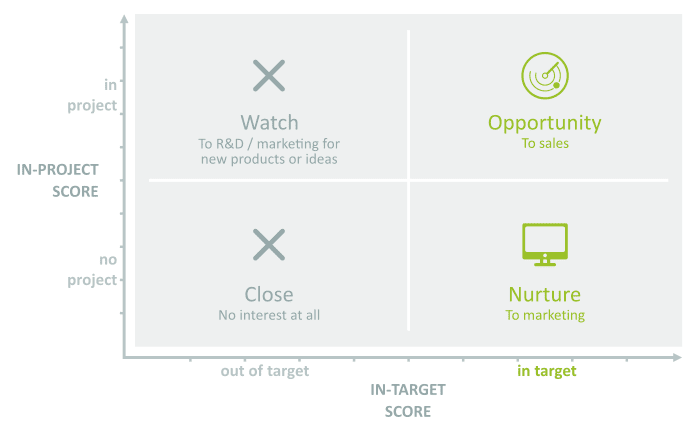Lead qualification 101 for chemical suppliers: from leads to business
Acquiring new customers is vital today for any company in any sector, and the specialty chemical industry is no exception.
With the digital era, marketing objectives have drastically switched from pure communications and sales support to complex online strategies aimed at one key objective: Generating leads.
Your marketing team has already generated a list of leads with contact details and a list of their interactions on your content, promotions and campaigns. Brilliant!
So, how do you actually close new deals with those leads? Hold on. Lead generation is just the first step.
Before dispatching leads to your sales team, you need to qualify your marketing leads to convert them into Sales Qualified Leads to know if there is a real sales opportunity among them:
 Position of the qualification in your lead conversion.
Position of the qualification in your lead conversion.
In today’s guide, we are giving you 4 steps to setup an effective lead qualification based on our 20-year experience at SpecialChem, helping hundreds of chemical and material suppliers to better manage their lead funnels.
Step 1: Define your MQL to select the right leads to qualify

It is easy to generate leads with digital. But you may easily get a huge list of leads. And rarely will you have the possibility to contact each of them, and this broad action would frankly be a waste of your resources.
Hopefully, not all of your marketing leads are the same. A glance at your lead list should be enough to realize that.
Before proceeding with qualification, you first need to understand what defines a Marketing Qualified Lead (MQL) to determine if further qualification is needed.
In a few words, an MQL is a lead that matches your buyer persona and who has demonstrated an interest in your chemicals or materials.
To determine if a lead is an MQL, you need to collect the necessary profile information — name, professional email address, company name, company activity, job position, market served and/or end application, etc. — and track the relevant online activity related to the person — email interactions, downloads, page views, form submissions, etc.
Read our simple guide to MQLs for chemical marketers to learn more.
Step 2: List the information to collect during the human qualification to turn MQL into SQL

When you start trudging through the lead jungle to identify business opportunities, you need to know what exact criteria makes it worthy to be an opportunity to pass onto sales.
Even if methodologies and wording may vary, the most advanced digital marketing companies all come to the same conclusion: When turning a MQL into a Sales Qualified lead, you need to take two dimensions into account. At SpecialChem, we name those two dimensions as follows:
- In-target score: is the lead from a company that you would like to see in your customer list?
- In project score: does the lead have an active project where your product could fit?
Once qualified, your lead will have two scores plotted on a two by two matrix: the Human Lead Qualification Matrix. This qualification matrix is split into four quadrants. Each quadrant includes specific next steps and follow-up actions as follows:

Example of the human lead qualification matrix that we use at SpecialChem
Both dimensions will be quantified if you take the time to set up the right scoring questions and convert the answers into a score.
How to measure the in-project score
To measure the in-project score, we recommend four criteria to validate during your qualification:
- the objective of project (ie material replacement, new application)
- the project schedule
- the willingness to test your product
- the ability to quantify the size of the project or its potential
What we have seen so far in the chemical industry is that these four criteria can be considered universal and can be used by nearly every supplier of chemicals and materials.
Each of the four criteria will contribute to your in-project score as follow:
- Precise or specific answer to each question: +2 Points each
- Generic or vague answer: +1 Point each
- No answer/no idea: +0 Point each
With four criteria, the maximum in-project score is 8 Points. If your lead’s in-project score is above 4 points your MQL is considered In-Project. If it’s below 4 points, the lead is considered to have no project/very low chance of a project.
How to measure the in-target score
The in-target score requires a bit more work from you, as the criteria will vary from one company to another.
The closer the lead is to your ideal buyer persona, the higher the score. Your objective is to find criteria that will help you to identify potential customers. Some of your criteria may be easy to collect via online forms, and we strongly advise you to do so. Other criteria will require one-to-one exchange, usually regarding the application performance requirements, etc.
Below are examples of the five in-target criteria we use for human lead qualification programs we manage for chemical suppliers:
- Geographical area: you may want customers in a specific country, or you may have restrictions to do business in others. Your product pricing, performance, or regulatory status may be a problem in some regions too.
- Position in the value chain: you might prefer a project at an integrated OEM versus a converter. Or your product might only be a viable option for a formulator and not a resin manufacturer.
- End-application: your product may not be a suitable fit in some applications for various reasons, and it would be a dead-end to initiate a testing phase. For example it’s not biocompatible for medical applications.
- Required or desired performance: Your product may be a good or bad candidate for a project depending on the critical product performance required. Let’s take the case of aesthetics. Poor scratch resistance of your plastic would make your product a bad candidate for a laptop casing, but your product would be acceptable for air conditioners panels.
- Regulations: Is there specific regulatory requirements that your product can or can’t pass? In some cases, meeting one specific regulation will make or break your product’s success in a given market or region.
Each of these five criteria will contribute to your in-target score as follow:
- Primary target — your ideal buyer persona: +2 Points each
- Secondary target — not ideal yet still interesting: +1 Point each
- Out of target — not interesting persona: 0 Point total
This calculation will result in a maximum in-target score of 10 Points. Above 5 points, the SQL is considered as in-target. Below 5 points your SQL is out-of-target.
Is your SQL really an opportunity?
If your SQL has a high score for “In-Project” (4 or above) and “In-Target” (5 or above), it is a business opportunity. Hurry! Dispatch it to your sales team! There is a hot business opportunity to follow-up, and quickly.
Want to go deeper? Check out our simple guide to SQLs for chemical marketers.
Step 3: Appoint inside sales to qualify your MQLs

Historically, leads were primarily generated by the sales team. Sales reps were the entry gate of the company for anyone interested in testing your products. Therefore, the development and conversion of these leads was naturally the responsibility of the sales team.
Today, we still see many chemical suppliers assigning all their marketing leads directly to the sales team. All those hundreds or thousands of leads generated through digital marketing are just thrown into a black hole of the sales team.
So on top of managing their existing buying customers, they are expected to manage these marketing-qualified leads. This is huge mistake.
Sales and business development managers are focused on handling and closing business opportunities. This is what they are paid to do, this is what they are good at, and this is their daily focus. Plus, lead qualification is a whole new world that is significantly different from the world of sales.
Inside sales representatives are the missing link between your marketing team that generates the marketing qualified leads (MQLs) — and your sales team that converts business opportunities into new buying customers.
The role of this inside sales representative is to qualify the Marketing Qualified Leads to convert them into Sales Qualified Leads. They are responsible to identify if there is a real business opportunity for the sales teams to focus on converting to a buying customer.
Unlike your sales/business development team, the inside sales representatives have the time, the focus, the incentive, the skills, and the process s to qualify leads in the right way.
Step 4: Contact your leads ASAP, and then do it again

In this digital time, we all expect speed.
When buying new products on Amazon, we want a confirmation email now. When chatting with a customer support, we want an answer now. Well, it is exactly the same when it comes to qualifying your leads.
Whether your leads downloaded content, or requested a sample, discussion, or price quote, you need to act quickly.
For an online request, the ideal target is within an hour up to 48h during the work week. Your chances of actually reaching the person to qualify them are considerably diminished after this time period.
For marketing leads identified through a document download, pursuing a lead qualification call after 24h is a good reactivity practice — your lead still remembers downloading your document — and has had time to review the content.
Now that you know who should qualify, what to collect and when to call, it is time to contact your lead.
Your objective is to have a first personal exchange with the lead. Keep in mind that you need to manage your expectations. Like any other action, there is a conversion rate, or a contact rate in this case. Just because you received a request or a person downloaded your documents does not mean that the lead will instantly answer your phone call or reply to your email. Don’t take it personally.
To maximize your chance of personal connection with the lead for qualification, be persistent.
Harvard Business Review claims that you need at least 6 call attempts to have a 90% chance of contacting a lead. Don’t give up after the first attempt. Try again now, tomorrow and even next week.
Second, don’t limit yourself to the phone. Use emails too. Your lead does not answer your calls? Send an email right after your call attempts, and call back the next day. Still not answering? Here's our secret weapon: the email reminder. Send an email with "RE:" in the subject line and a short reminder. A true miracle! This action will increase your chance of connection success!
Now you have all the cards in your hand to set up your “high-performing” lead qualification. Good luck!
If you think SpecialChem can be of further help, contact us. We have worked with hundreds of chemical suppliers to help them improve their lead qualification processes, and improve their conversion rate for leads to sales.